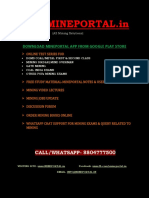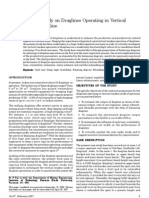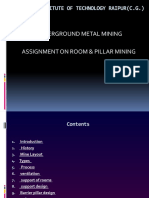0 ratings0% found this document useful (0 votes)
32 viewsBlock Caving Atri
Block Caving Atri
Uploaded by
ANSHUL YADAVMetal Mining
Copyright:
© All Rights Reserved
Available Formats
Download as PPT, PDF, TXT or read online from Scribd
Block Caving Atri
Block Caving Atri
Uploaded by
ANSHUL YADAV0 ratings0% found this document useful (0 votes)
32 views18 pagesMetal Mining
Copyright
© © All Rights Reserved
Available Formats
PPT, PDF, TXT or read online from Scribd
Share this document
Did you find this document useful?
Is this content inappropriate?
Metal Mining
Copyright:
© All Rights Reserved
Available Formats
Download as PPT, PDF, TXT or read online from Scribd
Download as ppt, pdf, or txt
0 ratings0% found this document useful (0 votes)
32 views18 pagesBlock Caving Atri
Block Caving Atri
Uploaded by
ANSHUL YADAVMetal Mining
Copyright:
© All Rights Reserved
Available Formats
Download as PPT, PDF, TXT or read online from Scribd
Download as ppt, pdf, or txt
You are on page 1of 18
BLOCK CAVING
INTRODUCTION
• Underground mining method that
has the potential to rival surface
mining in output and cost.
• This method was invented in the
years following World War I to
cope with the exploitation of the
massive low-grade copper
porphyry deposits of the south-
western United States.
INTRODUCTION
• Block caving is the mining method
in which masses, panel, or blocks of
ore are undercut to induce caving,
permitting the broken ore to be
drawn off below.
• Caving mechanics provides the basis
for understanding and controlling
the operating factors in block
caving.
• Good caving action generally
requires that the ore body have
fractures in three orientations.
THE METHOD
• To investigate the cavability of the ore body, drill cores are
obtained throughout the ore body using exploration openings.
• These cores are then often subjected to rock quality designation
(RQD) analysis, which measures the percentage of intact (>4 in.
Or 102mm) core recovered from a drill hole. The RQD value will
help to identify the caving characteristics of the rock mass.
• Cavability is not just a matter of achieving acceptable
fragmentation and optimum operating costs. From a safety
standpoint, the ore or capping must not arch over long distances
for long period of time. The formation of stable arches not only
disrupts the caving operation but very likely will cause air blast
and concussion in the mine when they suddenly collapse.
THE METHOD
• Determining the cavability of
an ore body is the first task to
be undertaken.
• After cavability is determined
for the ore body, the second
application of caving
mechanics is in draw control
and drawpoint spacing.
• Excessive spacing or deficient
one produces zones of draw
that may yield unsatisfactory
grade control and create
weight problems on sill
pillars.
THE METHOD
• In plan view, drawpoints may be arranged in a hexagonal or
square pattern.
• To ensure that the zones of draw completely blanket the ore,
drawpoint spacing is reduced somewhat, permitting minor
overlap of the zones.
• Once caving begins, the only means of regulating it, as well as
the production of ore, is through draw control.
• Because of irregularities in the contact between ore and
waste and, more important, because of funnelling in the ore,
some dilution is inevitable if a high recovery is achieved.
Effective draw control optimizes the combination of grade
control, recovery, and dilution.
THE METHOD
• The most critical spacings to
be designed into the block
caving operation are the
drawpoint spacings and the
spacings between levels.
• The spacing between levels
dictates how high a column of
ore is to be extracted through
the drawpoints.
VARIATIONS
• In block caving one of the critical parameters that determine
success is the size and shape of the area that is caved.
• Three methods are used: Block, Panel, and Mass.
1. In block caving, regular rectangular or square areas are
undercut in a checkerboard pattern. Usually these blocks are
mined in an alternating or diagonal order to effect better
caving action and draw control.
2. In panel caving, ore in continuous strips is mined across the
ore body.
3. For the coarser ore materials, loader caving is the best choice.
It also has the advantage of being the most versatile and least
expensive in terms of development costs.
4. Of the three methods, the loader method is often the choice
for today’s block caving operations.
SEQUENCE OF OPERATIONS
1. Mine level development commences from the shaft station
in the usual way, providing for high speed, high capacity
haulage and ample ventilation airflow capacity.
2. Main haulage ways are often paralleled by laterals,
interconnected by crosscuts, to ensure good ventilation and
to provide adequate lanes or stub crosscuts for loading.
3. One or more additional sublevels are required for grizzly or
slushier operation, increasing the development costs for
these two methods.
4. To provide ore-drawing facilities, chutes, drawpoints, or
trenches are prepared in the ore body under the block to be
mined.
SEQUENCE OF OPERATIONS
5. Finger raises to serve as prepass are then driven to the grizzly
sublevels above.
6. The most critical development step is undercutting the ore
zone, which is carried out in a manner similar to that of a
room-and-pillar mining operation, with the pillars being
withdrawn in a systematic manner across the cave zone.
7. The mining company generally relies on the knowledge of
rock mechanics to ensure that the caving proceeds in a
predictable manner.
CYCLE OF OPERATIONS
1. Drilling (undercut): pneumatic- or hydraulic-powered
percussion jumbos; hole size 2 to 3 in. (51 to 76 mm).
2. Blasting (undercut): ANFO, slurries; bulk charging by
pneumatic loader or pump, firing electrically or by
detonating fuse.
3. Secondary blasting (on sublevel or in haulage drift) : impact
hammer, dynamite bomb, drill and blast, mud cap
4. Loading (through bells and ore passes) : gravity flow to
chutes; LHD, front-end loader, slushier at drawpoints
5. Haulage (on main level): LHD, rail, truck, belt conveyor
CONDITIONS FOR APPLICATIONS
• Ore strength: weak to moderate or fairly strong, prefer
friable, fractured, or jointed rock, not blocky; should cave
freely under its own weight when undercut; free running, not
sticky if wet, not readily oxidized.
• Rock strength: weak to moderate, similar to ore in
characteristics.
• Deposit shape: massive or thick tabular deposit, fairly regular.
• Deposit dip: fairly steep(>60 degree) or vertical; can be fairly
flat if sufficiently thick.
• Deposit size: very large areal extent; thickness>100ft(30 m)
• Ore grade: Low, ideal for disseminated ore masses; most
suitable of underground methods for low-grade deposits.
CONDITIONS FOR APPLICATIONS
• Ore uniformity: fairly uniform and
homogeneous; sorting not possible
• Depth: moderate;>2000ft (600m) and <4000 ft
(1200m)
ADVANTAGES
• Relatively high productivity.
• Fairly low minimum cost, least of the underground mining
methods (relative cost about 10%).
• Highest production rate of the underground stoping methods;
large-scale method.
• High recovery (90 to 125%).
• Rock breakage in production occurs entirely by caving induced
by undercutting; no drilling and blasting cost in production.
• Suitable for gravity draw or fully mechanized materials
handling; repetitive, standardized operation.
• Ventilation is generally very satisfactory; good health and
safety factors.
DISADVANTAGES
• Caving and subsidence occur on a large scale.
• Draw control is critical to success of the method.
• Slow, extensive, costly development.
• Dilution may be high (10 to 25%).
• Maintenance of openings in production areas is substantial and
costly if pillars load excessively.
• Rigid, inflexible method.
• Hazardous work because of hang-ups in the grizzly and slushier
sublevels; some risk of air blast throughout the mine.
• Possible spontaneous combustion in ore or rock during caving if
drawing is slow or delayed (risk is high if sulphide content is >45%)
CONCLUSIONS
• If an opening made during stoping is large enough, it will
eventually cave, even in the firmest and strongest rock, but a
caving system of mining like block caving.
• At the bottom the block is completely undercut i.e. a
horizontal slot is blasted, which removes the support of the
over-lying ore.
• Due to complicated preparation and narrow sections
mechanized methods are often difficult to apply, except for
the preparation of the main level below the block.
• Underground mining method that has the potential to rival
surface mining in output and cost.
• At present block caving is not adopted at any of the mine in
India.
THANK YOU!!
You might also like
- John Deere Xuv 825i s4 Gator Utility Vehicle Operators ManualDocument108 pagesJohn Deere Xuv 825i s4 Gator Utility Vehicle Operators ManualLloyd Harvey100% (1)
- Sentinel Serial-Telenet Communication Guide v2 08102016Document68 pagesSentinel Serial-Telenet Communication Guide v2 08102016TOPOTRONIK100% (2)
- Cut and Fill MethodDocument26 pagesCut and Fill MethodANSHUL YADAVNo ratings yet
- Cut and Fill MethodDocument26 pagesCut and Fill MethodANSHUL YADAVNo ratings yet
- Detailed Technicalreport MIM18032018v1Document14 pagesDetailed Technicalreport MIM18032018v1Rozalia PengoNo ratings yet
- Unesco - Eolss Sample Chapters: Underground Mining Methods and EquipmentDocument8 pagesUnesco - Eolss Sample Chapters: Underground Mining Methods and EquipmentMayaraCarvalhoNo ratings yet
- Planning For Narrow Vein Mines: G GemellDocument4 pagesPlanning For Narrow Vein Mines: G GemellBendigo BanksNo ratings yet
- Surface Subsidence Engineering: Theory and PracticeFrom EverandSurface Subsidence Engineering: Theory and PracticeSyd S. PengNo ratings yet
- A Beginner's Guide To Eco Printing Fabric: Bonnie BowmanDocument4 pagesA Beginner's Guide To Eco Printing Fabric: Bonnie BowmanBagio Ranthe100% (2)
- JCB - 3dx Kirloskar EngineDocument1 pageJCB - 3dx Kirloskar EngineDhru TiNo ratings yet
- Metodos de Lavra SubterraneaDocument4 pagesMetodos de Lavra SubterraneaAmilton filhoNo ratings yet
- 1 112mn0424 Block CavingDocument17 pages1 112mn0424 Block CavingVineet Kumar Singh100% (1)
- Are You Looking For .: WWW - Promining.inDocument18 pagesAre You Looking For .: WWW - Promining.inANKIT DEOGADENo ratings yet
- Mining Engineering 1Document4 pagesMining Engineering 1phoebus ramirez100% (1)
- Lecture 3-Types of Underground Mining Methods - Lecture 3.Document9 pagesLecture 3-Types of Underground Mining Methods - Lecture 3.HILLARY FRANCIS SHENJERENo ratings yet
- Stoping MethodDocument51 pagesStoping MethodRathnakar Reddy100% (1)
- Metodos AtlasCopcopage35Document5 pagesMetodos AtlasCopcopage35lautaroi77No ratings yet
- Rock Blasting - A Practical Treatise On The Means Employed In Blasting Rocks For Industrial PurposesFrom EverandRock Blasting - A Practical Treatise On The Means Employed In Blasting Rocks For Industrial PurposesNo ratings yet
- Sub-Level Caving: Where Is It Headed?Document8 pagesSub-Level Caving: Where Is It Headed?anon_747293279No ratings yet
- Underground Mining TermsDocument3 pagesUnderground Mining TermsCristina Ortega CidNo ratings yet
- 25-04-2015 Underground Mine MethodsDocument50 pages25-04-2015 Underground Mine MethodsCo-leigh CornerNo ratings yet
- Assignment On Underground Metal MiningDocument38 pagesAssignment On Underground Metal MiningAnshul yadav0% (1)
- Selecting Methods of Extraction of Steeply Dipping Coal SeamDocument24 pagesSelecting Methods of Extraction of Steeply Dipping Coal SeammanikantaNo ratings yet
- Intership Repot Ofsmiore 69Document16 pagesIntership Repot Ofsmiore 69jagan100% (1)
- Pillar Design: Presented by Abhishek Vaidya 117MN0676Document14 pagesPillar Design: Presented by Abhishek Vaidya 117MN0676Prabhu PrasadNo ratings yet
- Practice Test 2 For GATE MiningDocument3 pagesPractice Test 2 For GATE MiningBishnu Sharma100% (1)
- Shrinkage StopingDocument14 pagesShrinkage StopingWilliam WatersNo ratings yet
- Room-And-pillar Method of Open Stope MiningDocument6 pagesRoom-And-pillar Method of Open Stope MiningIsmaelNo ratings yet
- Modes of AccessDocument24 pagesModes of AccessANSHUL YADAV100% (1)
- Longwall Mining Is A Form of UndergroundDocument31 pagesLongwall Mining Is A Form of UndergroundNaniNo ratings yet
- Are You Looking For .: WWW - Promining.inDocument27 pagesAre You Looking For .: WWW - Promining.inANKIT DEOGADENo ratings yet
- Pillar Design: DR - Ohn Thaik Department of Mining EngineeringDocument38 pagesPillar Design: DR - Ohn Thaik Department of Mining EngineeringohnthaikNo ratings yet
- Mine DevelopmentDocument4 pagesMine DevelopmentsunilsinghmNo ratings yet
- Narrow Vein MiningDocument23 pagesNarrow Vein MiningMatheus Gonçalves Peixoto da SilvaNo ratings yet
- Site Selection of An Incline or Pit:: R FurtherDocument6 pagesSite Selection of An Incline or Pit:: R FurtherSatyajeet ParidaNo ratings yet
- Mining Theory Q&ADocument48 pagesMining Theory Q&ARahul patelNo ratings yet
- Unit Operations in MiningDocument10 pagesUnit Operations in MiningNaveenNo ratings yet
- Drift and Fill - The High Value, High Recovery Mining SystemDocument8 pagesDrift and Fill - The High Value, High Recovery Mining SystemgeolukeNo ratings yet
- Rock Fragmentation - GoldsearchDocument32 pagesRock Fragmentation - GoldsearchSimon SamNo ratings yet
- Topic5 MiningMethods PartI SurfaceminingDocument76 pagesTopic5 MiningMethods PartI SurfaceminingAditya kumar GuptaNo ratings yet
- Horizon Mining Level Mining: Longwall & Other Methods of WorkingDocument14 pagesHorizon Mining Level Mining: Longwall & Other Methods of WorkingVamshiNo ratings yet
- Ballu Minor Project Report 2Document30 pagesBallu Minor Project Report 2virendra behraNo ratings yet
- Depillaring With StowingDocument24 pagesDepillaring With Stowingmohit kumar [NIT Rourkela]No ratings yet
- Mining Methods Under Ground MetalDocument24 pagesMining Methods Under Ground MetalSidharth0% (1)
- Cut & Fill StopingDocument13 pagesCut & Fill StopingJasmeet Singh SalujaNo ratings yet
- Surface Mine Design & Practice (MN)Document2 pagesSurface Mine Design & Practice (MN)Luigi Garcia CuevaNo ratings yet
- Metal Mining Stoping MethodsDocument51 pagesMetal Mining Stoping MethodsSheshu BabuNo ratings yet
- Code Subject L Ts MN 302 Mine Development 3 0 0Document2 pagesCode Subject L Ts MN 302 Mine Development 3 0 0Subhankar GhoshNo ratings yet
- Opening of Opencast MineDocument3 pagesOpening of Opencast MineArjun KumarNo ratings yet
- CH 3 - Preparation For ExcavationDocument15 pagesCH 3 - Preparation For ExcavationShubham GuptaNo ratings yet
- The Following Are The Some of The Important Parameter Which Generally Govern For Blast DesignDocument36 pagesThe Following Are The Some of The Important Parameter Which Generally Govern For Blast DesignmrbadsNo ratings yet
- Pit Planning and LayoutDocument7 pagesPit Planning and LayoutMarlinaTogumaJuniartiNapitupulu0% (1)
- Mining Technology - Engineering Notes IndiaDocument4 pagesMining Technology - Engineering Notes Indiaihateu1No ratings yet
- Class Notes PDFDocument5 pagesClass Notes PDFKumar RajanNo ratings yet
- DL Balancing DiagramDocument7 pagesDL Balancing DiagramJay Yadav100% (1)
- Chapter-3-Distribution of Air and Its ControlDocument21 pagesChapter-3-Distribution of Air and Its ControlSahil SokhalNo ratings yet
- Drilling & BlastingDocument24 pagesDrilling & BlastingDeepakIkhar100% (1)
- Room-And-pillar Panel Design MethodDocument6 pagesRoom-And-pillar Panel Design MethodDaniel SantanaNo ratings yet
- Mine Ventilation Notes For Beginners PDFDocument16 pagesMine Ventilation Notes For Beginners PDFalwcastillo100% (2)
- Surface Mine Design and PracticeeeeeeeeeeeeeeeeeeeeDocument56 pagesSurface Mine Design and PracticeeeeeeeeeeeeeeeeeeeeSelamet ErçelebiNo ratings yet
- Vol 1 3drillingDocument12 pagesVol 1 3drillingVamshi100% (1)
- Sublevel Stoping DrillingDocument13 pagesSublevel Stoping DrillingAndré Merino PérezNo ratings yet
- Room & Pillar MiningDocument43 pagesRoom & Pillar MiningANSHUL YADAVNo ratings yet
- Horizon MiningDocument2 pagesHorizon MiningVidya SagarNo ratings yet
- Underground Mining Methods Choice of MethodsDocument8 pagesUnderground Mining Methods Choice of MethodsAjeet Kumar100% (1)
- Shot Cretin GDocument13 pagesShot Cretin GANSHUL YADAVNo ratings yet
- National Institute of Technology RaipurDocument21 pagesNational Institute of Technology RaipurANSHUL YADAVNo ratings yet
- USBMIC8271 Block Caving Miami Mine Gila CountyDocument103 pagesUSBMIC8271 Block Caving Miami Mine Gila CountyANSHUL YADAVNo ratings yet
- Sublevel CavingDocument24 pagesSublevel CavingANSHUL YADAVNo ratings yet
- Under Ground Metal Mining Assignment: Topic:-Support System Submitted ToDocument55 pagesUnder Ground Metal Mining Assignment: Topic:-Support System Submitted ToANSHUL YADAVNo ratings yet
- Stope and Pillar Mining: 18.2.1 General FeaturesDocument10 pagesStope and Pillar Mining: 18.2.1 General FeaturesANSHUL YADAVNo ratings yet
- Top Slicing MethodDocument16 pagesTop Slicing MethodANSHUL YADAV100% (1)
- Shotcrete: Cementing Technology ForeverDocument25 pagesShotcrete: Cementing Technology ForeverANSHUL YADAVNo ratings yet
- Room & Pillar MiningDocument43 pagesRoom & Pillar MiningANSHUL YADAVNo ratings yet
- Study OF Esuing StopingDocument21 pagesStudy OF Esuing StopingANSHUL YADAVNo ratings yet
- Metal Mining IDocument59 pagesMetal Mining IANSHUL YADAVNo ratings yet
- Alimak Raise ClimberDocument17 pagesAlimak Raise ClimberANSHUL YADAVNo ratings yet
- Modes of AccessDocument24 pagesModes of AccessANSHUL YADAV100% (1)
- MetalDocument22 pagesMetalANSHUL YADAVNo ratings yet
- Jora RaiseDocument11 pagesJora RaiseANSHUL YADAVNo ratings yet
- Alimake Raise ClimberDocument20 pagesAlimake Raise ClimberANSHUL YADAVNo ratings yet
- A Presentation On Underground Stoping Methods - IIDocument68 pagesA Presentation On Underground Stoping Methods - IIANSHUL YADAV100% (1)
- Heat Exchangers Types & Applications, LMTD Derivation & ProblemsDocument16 pagesHeat Exchangers Types & Applications, LMTD Derivation & Problemsananth2012No ratings yet
- High Performance, Low Cost 1.8 To 54 MHZ Low Pass Filter-Jones - 2002-11Document5 pagesHigh Performance, Low Cost 1.8 To 54 MHZ Low Pass Filter-Jones - 2002-11Anna Terrè100% (1)
- Do Not Duplicate or Distribute Without Written Permission From CMKC!Document6 pagesDo Not Duplicate or Distribute Without Written Permission From CMKC!ChettamilsNo ratings yet
- 2018 - 1017 - 3GPP Summit - 03 - TSG-RAN - Bertenyi - NagataDocument17 pages2018 - 1017 - 3GPP Summit - 03 - TSG-RAN - Bertenyi - NagatajenhsinNo ratings yet
- Reflux Evaluation and Management of Laryngopharyngeal: Charles N. FordDocument8 pagesReflux Evaluation and Management of Laryngopharyngeal: Charles N. Forddanny wiryaNo ratings yet
- Pacheco Torgal Et Al. 2012Document6 pagesPacheco Torgal Et Al. 2012Like HalimNo ratings yet
- Periodic Table Melt PointDocument1 pagePeriodic Table Melt PointFidree AzizNo ratings yet
- Ultra 3Document6 pagesUltra 3marketing.socintecNo ratings yet
- rr1145 Soft Landing Systems Working at HeightDocument44 pagesrr1145 Soft Landing Systems Working at HeightChris ParkinsonNo ratings yet
- RANE Sl2 Manual DJDocument16 pagesRANE Sl2 Manual DJMatthieu TabNo ratings yet
- PHYS131 Fall 2019 JamalDocument3 pagesPHYS131 Fall 2019 JamalMujahed BrijieahNo ratings yet
- Cranial Nerve ExamDocument20 pagesCranial Nerve ExamSIR ONENo ratings yet
- Modicon M238 Hardware GuideDocument166 pagesModicon M238 Hardware Guidesoitbrave6No ratings yet
- Inspection Plus Software For Machining Centres With Fanuc and Meldas ControllersDocument178 pagesInspection Plus Software For Machining Centres With Fanuc and Meldas ControllersSava Iulian100% (1)
- Sikatop 122 F: Fibre Reinforced, Polymer Modified Repair MortarDocument3 pagesSikatop 122 F: Fibre Reinforced, Polymer Modified Repair MortarTiger CageNo ratings yet
- Istorija: Simca 1100Document24 pagesIstorija: Simca 1100Zastava 101 KlubNo ratings yet
- Datasheet Argo Diode Battery Isolators enDocument1 pageDatasheet Argo Diode Battery Isolators enDavor GiaconiNo ratings yet
- Stars Above - B&W PagesDocument42 pagesStars Above - B&W PagesJoe ReddamNo ratings yet
- 2011 CDW ReportDocument240 pages2011 CDW ReportJustinas SinkevičiusNo ratings yet
- Quarter 4 Performance Task DetailedDocument16 pagesQuarter 4 Performance Task DetailedJireh AlveyraNo ratings yet
- Flexible, Hybrid Solution Now With Bi-Directional Wireless DUAL TECDocument2 pagesFlexible, Hybrid Solution Now With Bi-Directional Wireless DUAL TECAnonymous XYAPaxjbYNo ratings yet
- 2012E01 SaltLakewaterSupplyDocument13 pages2012E01 SaltLakewaterSupplyAbhishek AgarwalNo ratings yet
- Cultural Requirements of Roses: Design For Everyday LivingDocument2 pagesCultural Requirements of Roses: Design For Everyday LivingAnonymous loKgurNo ratings yet
- LV Pre Int GrammarDocument1 pageLV Pre Int Grammar4myswagNo ratings yet
- Maximum Power Transfer Theorem Case 1 125274Document1 pageMaximum Power Transfer Theorem Case 1 125274akashdeep tickooNo ratings yet
- EMTL Question PaperDocument2 pagesEMTL Question PaperJayaram KrishnaNo ratings yet








































































































